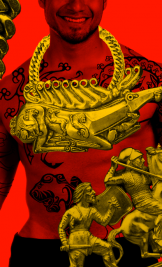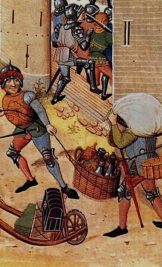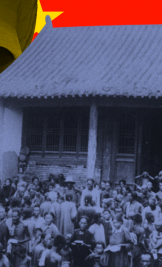

Stone Age sex tour: who slept with whom
A monogamous marriage, typical for modern society, emerged with the development of agriculture and the emergence of personal property, which required an heir to pass it to. The hunter-gatherers of the early Stone Age had a more intense sexual life.
The Stone Age began 3 million years ago, when human ancestors separated from the animal kingdom, and ended when people began to use metal, which was only 5 to 6 thousand years ago. Researchers have different opinions about sex during this period.
In one of her interviews, American anthropologist Helen Fisher said that primitive women were constantly going into bushes with different partners. According to her, our ancestors, following the call of hormones and still vivid animal instincts, thought only about sex. British archaeologist Timothy Taylor agrees with her. He believes that men of the Stone Age did not have large penises; genitals grew due to frequent sex for pleasure and not for reproduction.
Classical science is more reserved in its conclusions. Over the course of 3 million years, humans have been evolving physically and mentally, which has led to the complication of social relationships, including sex.
Experts from the University of British Columbia invited thousands of volunteers to assess the sexual attractiveness of the opposite sex. Women mostly chose morose and warlike men, while men chose smiling girls. The researchers concluded that men subconsciously perceive a smile as a symbol of vulnerability and submission. There is a trace of our primitive past in this reaction.
When everything was common
At the stage of a primitive human pack, albeit a thinking one, promiscuity prevailed, that is, chaotic, unrestricted sexual intercourse among all members of the species. At the same time, members of the pack competed. Stronger males formed harems, while weaker ones were forced to satisfy themselves through masturbation or homosexuality, just as in the animal world, the leader sexually dominates over the weaker male, demonstrating his superiority. The research of British anthropologist Edward Evans-Pritchard shows that homosexuality was also practiced to initiate young people into adulthood.
At the same time, prostitution and tradition of giving gifts to women were born. Primitive society was dominated by primitive communism where everything was common, including women. And the survival of the herd depended on male hunters who got food, drove away animals and competitors from other groups. From time to time, men would visit the caves where women and children lived separately and choose the one who would give them affection that night. In the morning, the chosen one would receive the largest piece of meat or a skin that would keep her warm at night.
When modern girls dress up in front of the mirror, they subconsciously perform the ritual of their primitive ancestors, who decorated themselves with shells and juice from crushed berries. When a man gives a girl a gift on their first date and takes her to a restaurant, he is also acting like a primitive man. People of the Stone Age believed that a well-fed and warmed woman would be more affectionate and amenable to sex.

The age of strangers
In the Middle Paleolithic period, 300 to 35 thousand years ago, a family emerged from the herd, and humans appeared in their modern anatomical form. A community of 20 to 140 people was united by kinship, and was most likely ruled by women. Promiscuity was replaced by exogamy, that is, sexual relations between members of the same family were forbidden.
It was allowed to take a ‘wife’ or a ‘husband’ only from the outside, so neighboring primitive families tried to be friends. Later, tribes would emerge from families, and nations from tribes. There were reasons for this:
- people began to notice that sexual contact with relatives bred children with disabilities;
- ancient humans developed emotionally and began to distinguish their own self more clearly, thus, jealousy appeared;
- the kin had to establish ties with its neighbors for the sake of trade, mutual assistance and protection.
Besides, men continued to hunt, and often travelled tens or even hundreds of miles from their campsite. On these journeys, hunters met other families, whose elders offered them intimate relations with local women. A similar practice has long persisted among the Chukchi, Tibetan peoples, and Aboriginal Australians. Strict rituals and systems of social prohibitions emerged. Violators were punished to maintain order.

The mystery of the Red Trio
Near the Czech town of Dolní Věstonice, archaeologists have discovered one female and two male skeletons in a group burial; these people were 17 to 23 years old. They are known in the scientific world as the Red Trio, as their bones were covered with ochre. The burial is 26 thousand years old, and the most amazing thing is that after death, a flint knife was stuck into the genitals of one of the males, and a wooden stake in the other one’s.
The woman was laid between the two men. The hand of the left corpse was placed over the woman’s vagina. The body was turned, as if the man was looking at the woman with lust. The woman’s hand was intertwined with the hand of the man on the right, as if they had close relationship.
A lot of ochre was poured on the woman’s pubis and the left man’s head, with wolf teeth also stuck into the latter. The study found that the trio died suddenly, and was buried less than an hour later. Scientists have been trying to solve the mystery of this burial for over 60 years. Most likely, the trio broke some primitive law and was punished. There is a certain theatricality in the burial rite itself, which was probably meant to convey the consequences of breaking the taboo to other people.


Marriage gatherings
Treating everything as common, the kin depersonalised an individual. The needs of the community were more important than personal desires of its individual member. In order to procreate, marriage gatherings between two or more neighbouring families were arranged. Participants met on special territories to have sex with each other. This practice effectively made primitive marriage a group one.
A possible place for such meetings could be a cave in Bavaria, where the walls are decorated with erotic drawings. It has natural fossils resembling male genitals. German archaeologist Bernhard Haeck, who studied the discovery, noted that Stone Age people considered the cave sacred, and possibly celebrated fertility festivals or performed certain magical rituals there. Similar caves have been discovered in France and Spain.
Echoes of the practice of marriage meetings can be found in the pagan traditions of Kievan Rus, in the festivities of young people from neighbouring villages on Kupala night, Maslenitsa and Koliada. On the festive days, harsh restrictions were eased and boundaries erased, and boys and girls had their first sexual experience, looking for a future mate.
The Inuit peoples of Greenland also had a similar custom. Several times a year, men and women would go to the fields, set up tents, and have group sex in complete darkness. Children born after that night were considered legitimate. This custom helped the families to renew their blood under conditions of the island’s small population. European settlers eagerly adopted the tradition and practiced it until the 20th century.

It was already written in the 12th century: ‘Love makes an ugly and rude person shine with all beauty.’ Test your feelings with 31 rules of medieval love.
Festivals end
Our ancestors were also familiar with masturbation. While excavating a site in Germany, near the city of Ulm, archaeologists discovered realistic dildos made of stone. Those are at least 28 thousand years old, and, according to experts, were not always used for ritual purposes, because at that time, it’s female genitals that were associated with fertility.

In an interview to The Times, American archaeologist Timothy Taylor said that such things are found quite often and everywhere. Primitive people actively used sex accessories and practiced fetishism. This can be proved by Paleolithic Venus figurines, of which more than 200 have been found.
The emergence of Venuses, the earliest of which is 35 thousand years old, is associated with the beginning of matriarchy. Statuettes with distinct female genitalia, large hips and breasts, served as the attributes of a socially complex, enlarged tribe. The number of people was growing, sexual relations were developing.
And then this damn agriculture has emerged.










